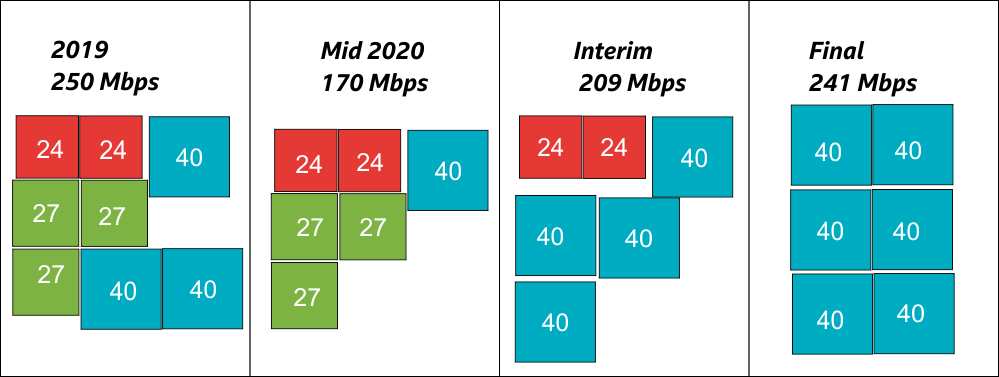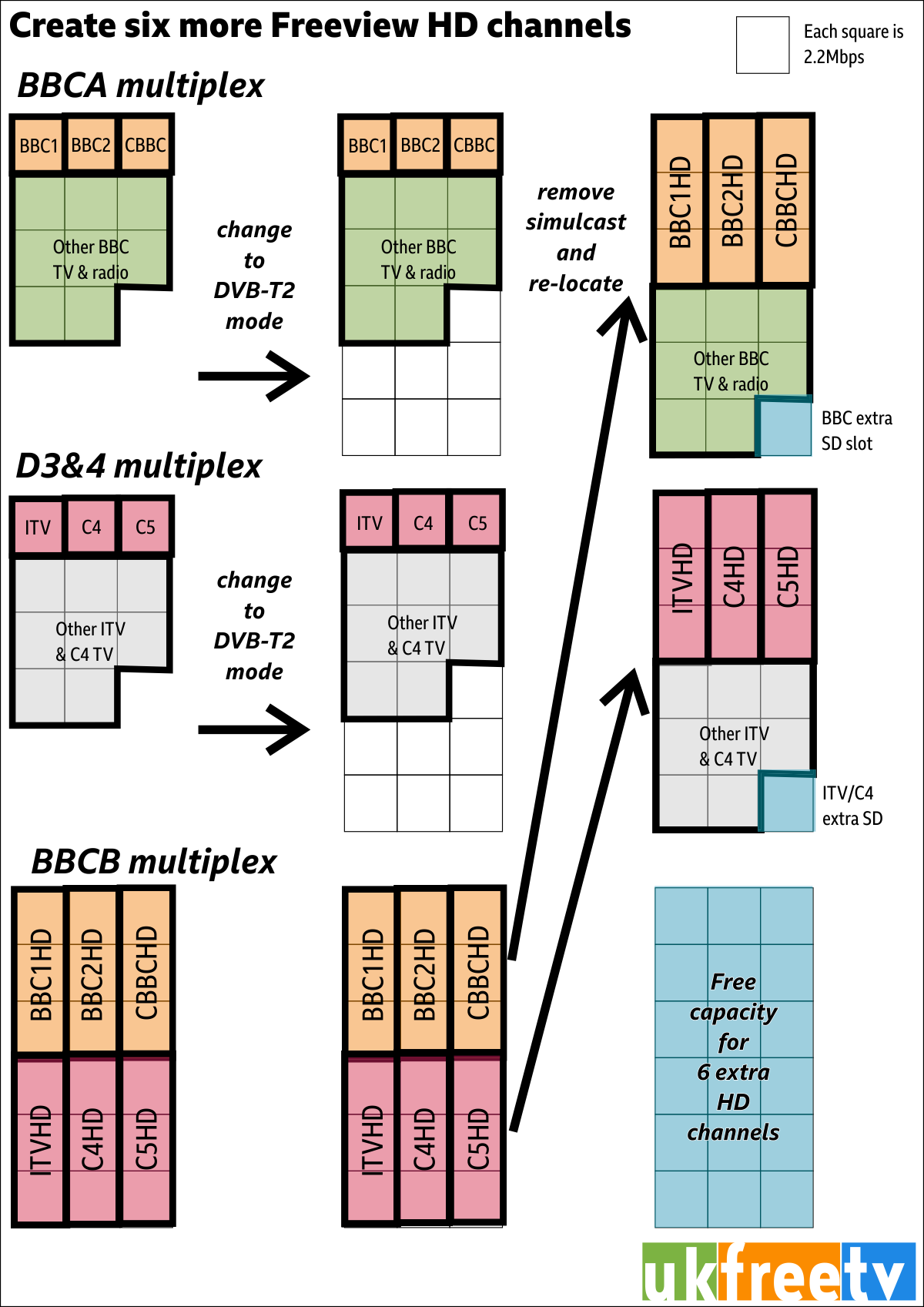Rebuilding Freeview High Definition from 2019 onwards

As Freeview High Definition users in Cornwall already know, the number of TV channels being broadcast in the UK will be cut back in mid-2020 to make way for the fifth generation of mobile phone data services.
This is because the number of multiplexes being broadcast will be cut back to the original six. The extra two were provided as a “interim service”. A Freeview multiplex is a single broadcast of binary data that occupies a 8MHz frequency range. In the UK each of these can carry 24.1, 27.1 or 40.2Mbps or of data.
Because older TV sets and set-top boxes can only work with 24.1 Mbps, it is only possible for the owners of the multiplexes to use the higher capacity modes when every home has switched to Freeview HD capable equipment. This equipment is marked with “DVB-T2”.
As illustrated, the total bitrate (in a home that can receive all the multiplexes) will change over time.

Meet the multiplexes
Not all the multiplexes are the same:
- only three are broadcast to the whole of the UK;
- a different three are broadcast in the better DVB-T2 mode;
- legally, only BBC channels may appear on BBCA
- also, legally, only public service broadcast channels (ITV, C4, C5) can appear on D3&4
- The HD mode multiplexes have more bits and use a more video efficient encoding system (MPEG-4)
- The current license to broadcast have different end-dates
This can be summaries in this table.
|
Multiplex name |
Expires |
HD mode? |
Coverage |
Mode |
Bitrate today |
||
|
com7 |
21 June 2020 |
Yes |
76% |
6 |
40.2 |
||
|
com8 |
21 June 2020 |
Yes |
76% |
6 |
40.2 |
||
|
D3&4 |
15 November 2022 |
No |
100% |
3 |
24.1 |
||
|
ARQA |
15 November 2026 |
No |
90% |
8 |
27.1 |
||
|
ARQB |
15 November 2026 |
No |
90% |
8 |
27.1 |
||
|
SDN |
15 November 2026 |
No |
90% |
8 |
27.1 |
||
|
BBCB |
16 November 2026 |
Yes |
100% |
6 |
40.2 |
||
|
BBCA |
31 December 2027 |
No |
100% |
3 |
24.1 |
Freeview requires about 2.2Mbps for a standard definition channels and three times that for a high definition one (6.7Mbps).
The Freeview HD EPG problem
One problem for people with Freeview HD receivers will note is that HD channels are grouped together in the program guide, rather than appear as replacements for the standard definition channels as viewers expect. This is because the six channels on the BBCB multiplex (BBC One, BBC Two, CBBC, ITV, Channel 4 and Channel 5) can only be seen on newer boxes, making channel number replacement impossible without breaking the oldest Freeview equipment.
Basically the UK-wide BBCA and D3&4 multiplexes can’t change mode until ALL homes can receive them.
The interim position
There is good news, however, for the SDN, ARQA and ARQB multiplexes. They can switch modes to the high definition whenever they feel that it is commercially practical. This might be at a lower level of Freeview HD box use, perhaps 80% or 90%.
By switching to DVB-T2 mode, each of them can increase their capacity from 27.1 to 40.2Mbps and take advantage of MPEG4.
.png)
So, of the 80Mbps lost when com7 and com8 close, half of that can be got back by SDN, ARQA and ARQB upgrading, which would be enough for an extra 6 full HD services.
The HD public service channels
This diagram explains what will happen to create space six more Freeview HD channels.

The gains for the BBC when everyone has a DVB-T2 receiver are larger. It will:
- No longer need half of the capacity on the BBCB multiplex (20.1Mbps) as it can move these channels to BBCA
- Gain 16.1 Mbps on BBCA due to the mode change;
- Gain 6.6 Mbps from not simulcasting three services in SD and HD
- Use the “gained 22.1Mbps” Be able to supply all the BBC television channels in HD to all UK homes
For the D3&4 multiplex, the gains are similar:
- No longer need the 20.1Mbps on BBCB, making it available for other UK-wide services.
- Gain 16.1 Mbps on D3&4 due to the mode change;
- Gain 6.6 Mbps from not simulcasting three services in SD and HD
- Be able to broadcast ITV, C4 and C5 in HD to all UK homes
I hope that's as clear as possible! Any qestions?
6:37 PM
@StevensOnln1 Thanks for the clarification on that.
| link to this comment |
Hi
Just found that HD signals from Whitehawk were extended last week
to channel 51 whilst 36 still remains. My TV seemed to switch to 36
so had unusable HD for a few days until my aerial guy found this out.
My aerial ( 1mile away ) really struggled with the new ch36,
very blocky, but 51 is perfectly fine. Had to manually tune back to 51
Any idea if 51 will get turned off or why we now have two HD signals ?
| link to this comment |
1:20 PM
Mike Scofield: Whitehawk Hill has not extended any coverage last week. There are currently separate filler broadcasts of the PSB1-3 multiplexes which began last year on the new frequencies (UHF channels 48/35/36), in order to prevent some viewers loosing coverage of the main PSB multiplexes on their existing frequencies whilst frequency changes are taking place. The existing PSB3 multiplex on UHF channel 51 will move to UHF channel 36 later this year. You would appear to be in an area where both frequencies can be received.
| link to this comment |
Thanks very much. Its strange that it only started to a problem for us last week.
But ok, maybe just a coincidence.
Will 36 increase its power when 51 is switched off because at the moment
36 is unusable.
Cheers and thanks again.
| link to this comment |
12:56 PM
Our tv returned itself and we have now lost itv west channel 3? And all itv channels can you advise. We have re tuned a number of times but it is not picking it up? We are based in saltford bristol
| link to this comment |
1:42 PM
Carol: Have you checked for any loose or damaged cables or connections behind your TV? Please provide a full postcode so that we can see which transmitter you're receiving, where you are in relation to it and your predicted coverage etc.
| link to this comment |
Lost the Smithsonian channel on Freeview 99 (Winterhill Tx) over the weekend. A quick check shows the rest of the Com7 channels are also 'No Signal'. Two tvs with separate antenna show this.
I can't find anything on line to explain this.
Any update would be appreciated.
Thank you
| link to this comment |
10:39 PM
Alan:
There is no known fault at the transmitter and there are no other reports of the loss you are experiencing. Therefore you must have a problem with your equipment. Start by checking all the aerial cables for damage, etc. Then unplug all the coaxial plugs/sockjets and refit them. Then check the signal strengths on all the multiplesex. Ideally you whould get between 60% and 85%, any more or any less is likely to give you problems.
| link to this comment |
Thanks for the prompt response. I'll go through the checks and let you know what happens.
| link to this comment |
11:11 PM
Hi!
I reside in Belfast Northern Ireland and my question relates to changes due to COM7 HD and COM8 HD. Currently I receive COM7 HD on UHF 33 and COM8 HD on UHF 34. There is a retune event due for both COM7 HD and COM8 HD on the 4th September 2019. This retune will move COM7 HD currently on UHF 33 to UHF 51 and COM8 HD currently on UHF 34 to UHF 60. A further retune event is planned for the period January to March 2020. In this retune COM7 HD will move to UHF 55 and COM8 HD to UHF 56. My interest in these retunes is; I currently receive Saorview from the RTE transmitter located Clermont Carn in North Co. Louth. They currently use two Multiplexes and they transmit on UHF 52 and UHF 56. Does anyone on UKFreeTV know what will happen to Saorview at the retune planned for the period January to March 2020?
| link to this comment |
